|
Historical
Information

Racine
Harbor had been continuously lighted since 1838 when the Root River
lighthouse became one of the first lights to be constructed on Lake
Michigan.
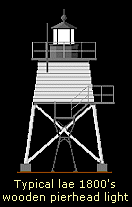 Maritime commerce in and out of Racine
harbor experience continued growth, and the piers continued to be lengthened
commensurately to contain an ever expanding area of protection. With
such lengthening, It was inevitable that a pier head light would also be
needed to mark the ends of the lengthened piers, and to that end a
Lighthouse Board work party arrived in Racine in July, 1872 to construct
a standard wooden beacon light with elevated walk at the outer end of
the north pier. Work progressed quickly, with the new light exhibited
for the first time on the night of September 5 of that year. Maritime commerce in and out of Racine
harbor experience continued growth, and the piers continued to be lengthened
commensurately to contain an ever expanding area of protection. With
such lengthening, It was inevitable that a pier head light would also be
needed to mark the ends of the lengthened piers, and to that end a
Lighthouse Board work party arrived in Racine in July, 1872 to construct
a standard wooden beacon light with elevated walk at the outer end of
the north pier. Work progressed quickly, with the new light exhibited
for the first time on the night of September 5 of that year.
The old 1838 coast light was demolished
in 1876, its timbers and bricks reportedly used in the construction of a
private dwelling.
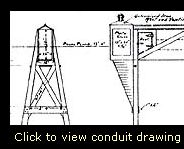 As part of an improvement project being
undertaken on all of Lake Michigan's pierhead lights under Eleventh
District Engineer Major Milton B. Adams, a conduit system for the
pierhead light was constructed on the north pier, designed to allow the
lamp to be fueled and maintained from a point shoreward of the beacon.
With the illumination of this mew conduit-mounted light on the night of
May 28, 1894, the pierhead beacon was discontinued. Unfortunately, while
Major Adams' conduit system sounded like an excellent idea, it was found
to be less than reliable, and once again a pierhead light with a Sixth
Order Fresnel and fog bell was reestablished on the north pier on June
18, 1969, the conduit system removed, and 438 feet of elevated walk
constructed in its place. As part of an improvement project being
undertaken on all of Lake Michigan's pierhead lights under Eleventh
District Engineer Major Milton B. Adams, a conduit system for the
pierhead light was constructed on the north pier, designed to allow the
lamp to be fueled and maintained from a point shoreward of the beacon.
With the illumination of this mew conduit-mounted light on the night of
May 28, 1894, the pierhead beacon was discontinued. Unfortunately, while
Major Adams' conduit system sounded like an excellent idea, it was found
to be less than reliable, and once again a pierhead light with a Sixth
Order Fresnel and fog bell was reestablished on the north pier on June
18, 1969, the conduit system removed, and 438 feet of elevated walk
constructed in its place.
In order to further increase the
protected harbor area, twin breakwaters were constructed around the
harbor in the late 1890's. With the completion of these a temporary
fixed red lens lantern was established at the southerly end of the
breakwater on October 13, 1900.
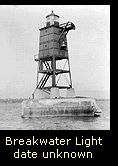 Also in this year, it was decided to
replace the 1865 Root River Light with a larger steel light at the
pierhead. To this end, the old wooden beacon was temporarily moved 24
feet towards the end of the pier to allow space for the construction of
a concrete crib to support the new heavier steel tower. Contracts for
supplying the steel and cast iron for the new light were issued, and the
materials were delivered at the Milwaukee depot. The materials were
subsequently transported to Racine, where the tower was erected on the
pierhead, and exhibited for the first time on the night of November 23,
1902, and the wooden pierhead light was demolished. Also in this year, it was decided to
replace the 1865 Root River Light with a larger steel light at the
pierhead. To this end, the old wooden beacon was temporarily moved 24
feet towards the end of the pier to allow space for the construction of
a concrete crib to support the new heavier steel tower. Contracts for
supplying the steel and cast iron for the new light were issued, and the
materials were delivered at the Milwaukee depot. The materials were
subsequently transported to Racine, where the tower was erected on the
pierhead, and exhibited for the first time on the night of November 23,
1902, and the wooden pierhead light was demolished.
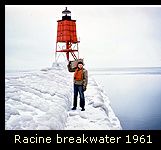 With the establishment of this new
light, the 1865 Light was simultaneously discontinued, and work began on
converting the old station into a dwelling large enough for the head
keeper and his assistant. With the establishment of this new
light, the 1865 Light was simultaneously discontinued, and work began on
converting the old station into a dwelling large enough for the head
keeper and his assistant.
In 1910, iron and steel was delivered
to the harbor for the construction of an improved breakwater structure.
When erected, the new steel tower stood 46 feet tall, with its fixed red
Fourth Order Fresnel placed at a focal plane of 53 feet and a visibility
range of 14 miles in clear weather. By 192, the tower had been equipped
with an air-powered diaphone fog-signal with a 20 second characteristic
consisting of a one-second blast followed by 2 seconds of silence, a
second blast of 1 second followed by 16 seconds of silence.
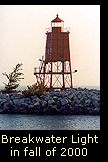 With the assumption of responsibility
for aids to navigation in 1939, the old 1865 station and the adjacent
life-saving station became united as part of the new Racine Coast Guard
Station. With the assumption of responsibility
for aids to navigation in 1939, the old 1865 station and the adjacent
life-saving station became united as part of the new Racine Coast Guard
Station.
After having seen their treasured Racine Reef Light fall to the
wrecking ball at the hands of the Army Corps of Engineers in 1961, when the people of Racine heard that the Coast
Guard was planning on putting the Pierhead Light under the wrecking ball
in 1987, a huge public outcry arose, and the structure was saved to be
incorporated incorporated as a featured part of the new Reefpoint Marina
complex,
where it can be seen to this day.
Keepers of these Lights

Click Here to see a complete listing of
all Racine North Breakwater Light keepers compiled by Phyllis L. Tag of
Great Lakes Lighthouse Research.
Seeing these Lights

Racine Harbor has obviously seen a great deal of renovation in recent
years, with landscaping and observation points spread between the
breakwaters, around the marina and the harbor entrance.
We made our way out to
the harbor entrance and climbed the observation tower that sits directly
across the channel from the lighthouse. From the number of small boats
that were trolling up and down the cannel, it was plain to see that the
salmon were running. We took a couple of photographs of the light, and
dismounted the platform to wander the marina.
As we walked around the
marina, we saw a number of fishermen sitting along the piers and
breakwaters. A number of them had salmon lying on the bank behind them,
some of which were incredibly large.
Finding this Light

 From I-94, take Hwy 20 east. Hwy 20 eventually becomes Washington
Ave. Follow Washington Ave. to Hwy 32, and head north on Hwy 32. Turn
right on Christopher Columbus Causeway, and follow around the marina
until the road ends in a parking area. Walk the short distance to the
lighthouse at the marina entrance. From I-94, take Hwy 20 east. Hwy 20 eventually becomes Washington
Ave. Follow Washington Ave. to Hwy 32, and head north on Hwy 32. Turn
right on Christopher Columbus Causeway, and follow around the marina
until the road ends in a parking area. Walk the short distance to the
lighthouse at the marina entrance.
Reference
Sources

Inventory
of Historic Light Stations, National Parks Service, 1994.
USCG Historians office, Photographic
archives.
Annual Reports of the Lighthouse Board, various, 1859 through
1909
1961 photograph of the Racine Coast Guard station by Jerry Schober.
Photograph from the Racine Historical Society collection.
Personal observation at Racine Harbor, 09/08/2000 & 09/09/2000.
Photographs from author's personal collection.
Keeper listings for this light appear courtesy of Great
Lakes Lighthouse Research |
 Maritime commerce in and out of Racine
harbor experience continued growth, and the piers continued to be lengthened
commensurately to contain an ever expanding area of protection. With
such lengthening, It was inevitable that a pier head light would also be
needed to mark the ends of the lengthened piers, and to that end a
Lighthouse Board work party arrived in Racine in July, 1872 to construct
a standard wooden beacon light with elevated walk at the outer end of
the north pier. Work progressed quickly, with the new light exhibited
for the first time on the night of September 5 of that year.
Maritime commerce in and out of Racine
harbor experience continued growth, and the piers continued to be lengthened
commensurately to contain an ever expanding area of protection. With
such lengthening, It was inevitable that a pier head light would also be
needed to mark the ends of the lengthened piers, and to that end a
Lighthouse Board work party arrived in Racine in July, 1872 to construct
a standard wooden beacon light with elevated walk at the outer end of
the north pier. Work progressed quickly, with the new light exhibited
for the first time on the night of September 5 of that year. As part of an improvement project being
undertaken on all of Lake Michigan's pierhead lights under Eleventh
District Engineer Major Milton B. Adams, a conduit system for the
pierhead light was constructed on the north pier, designed to allow the
lamp to be fueled and maintained from a point shoreward of the beacon.
With the illumination of this mew conduit-mounted light on the night of
May 28, 1894, the pierhead beacon was discontinued. Unfortunately, while
Major Adams' conduit system sounded like an excellent idea, it was found
to be less than reliable, and once again a pierhead light with a
As part of an improvement project being
undertaken on all of Lake Michigan's pierhead lights under Eleventh
District Engineer Major Milton B. Adams, a conduit system for the
pierhead light was constructed on the north pier, designed to allow the
lamp to be fueled and maintained from a point shoreward of the beacon.
With the illumination of this mew conduit-mounted light on the night of
May 28, 1894, the pierhead beacon was discontinued. Unfortunately, while
Major Adams' conduit system sounded like an excellent idea, it was found
to be less than reliable, and once again a pierhead light with a  Also in this year, it was decided to
replace the 1865 Root River Light with a larger steel light at the
pierhead. To this end, the old wooden beacon was temporarily moved 24
feet towards the end of the pier to allow space for the construction of
a concrete crib to support the new heavier steel tower. Contracts for
supplying the steel and cast iron for the new light were issued, and the
materials were delivered at the Milwaukee depot. The materials were
subsequently transported to Racine, where the tower was erected on the
pierhead, and exhibited for the first time on the night of November 23,
1902, and the wooden pierhead light was demolished.
Also in this year, it was decided to
replace the 1865 Root River Light with a larger steel light at the
pierhead. To this end, the old wooden beacon was temporarily moved 24
feet towards the end of the pier to allow space for the construction of
a concrete crib to support the new heavier steel tower. Contracts for
supplying the steel and cast iron for the new light were issued, and the
materials were delivered at the Milwaukee depot. The materials were
subsequently transported to Racine, where the tower was erected on the
pierhead, and exhibited for the first time on the night of November 23,
1902, and the wooden pierhead light was demolished. With the establishment of this new
light, the 1865 Light was simultaneously discontinued, and work began on
converting the old station into a dwelling large enough for the head
keeper and his assistant.
With the establishment of this new
light, the 1865 Light was simultaneously discontinued, and work began on
converting the old station into a dwelling large enough for the head
keeper and his assistant.  With the assumption of responsibility
for aids to navigation in 1939, the old 1865 station and the adjacent
life-saving station became united as part of the new Racine Coast Guard
Station.
With the assumption of responsibility
for aids to navigation in 1939, the old 1865 station and the adjacent
life-saving station became united as part of the new Racine Coast Guard
Station. From I-94, take Hwy 20 east. Hwy 20 eventually becomes Washington
Ave. Follow Washington Ave. to Hwy 32, and head north on Hwy 32. Turn
right on Christopher Columbus Causeway, and follow around the marina
until the road ends in a parking area. Walk the short distance to the
lighthouse at the marina entrance.
From I-94, take Hwy 20 east. Hwy 20 eventually becomes Washington
Ave. Follow Washington Ave. to Hwy 32, and head north on Hwy 32. Turn
right on Christopher Columbus Causeway, and follow around the marina
until the road ends in a parking area. Walk the short distance to the
lighthouse at the marina entrance.